Sometimes our brains just don’t want to play ball. Whether it’s an inability to concentrate, a tendency to forget where we left our keys, or a mental block on that final crossword clue, there are times when our minds seem to have – well – a mind of their own.
Like any machine, our brains can sometimes benefit from a tune-up, and we’ve collected the latest thinking around six key areas of cognition, and provide some practical, science-backed tips on how to keep your mental cogs running smoothly.
1
Attention
From broad beam to laser focused, it’s your flexible friend.
We’ve all experienced that irritating feeling of being distracted from the task at hand. But don’t be too hard on your butterfly mind: our brains have evolved, for good reason, to be distractible. We prize an ability to concentrate, but we need our attention to be flexible. If we focused too tightly we’d miss the creaking floorboard that signifies an intruder, or the whiff of smoke that announces fire.
Attention has proven to be much more complicated, and weirder, than it seems. If you look closely at something – a photo of a landscape, say – you probably feel that you are noticing everything when, in fact, you’re taking in just a few bits at a time. This is because the more you concentrate, the narrower your view becomes. Inattentional blindness, as this is known, has spawned dozens of demonstrations.
The most famous is a video of a group of people passing a basketball to each other. As the passes continue, a person in a gorilla suit walks into the middle of the group and beats his chest before slowly walking off. If you show the video to people who’ve never seen it before and instruct them beforehand to watch the ball closely, nearly all of them fail to see the gorilla because it falls outside the laser beam of their attention.
Multitasking has also taken a knock in the lab. Recent research at Princeton University has shown that the feeling of attending to more than one thing at once is a delusion – what’s actually happening is that our brains are rapidly switching back and forth from one thing to another. Even when we concentrate on a single task, our attention disengages several times a second, as our brains check that nothing important is happening elsewhere. This creates split-second gaps in our focus. When we try to multitask, these gaps tend to get so large that we don’t do any of the tasks well. That’s why driving while using a phone is so dangerous.
Physically, attention is marked by neural activity in the brain areas concerned with the object of attention. If you’re listening to music, for instance, neurons will be sparking in your auditory cortex (near the ears). If you’re studying a picture, there will be activity in your visual brain (at the rear of the head). Areas in the parietal brain lobes (upper rear of the brain) direct attention in three-dimensional space. The more you’re focusing on something, the more intense and persistent the activity. So-called gamma brainwaves, produced by neurons firing more than 25 times per second, signify intense focus, while slower brainwaves show more diffused, meandering attention.
The rear of the parietal lobe is particularly important for attention because it directs your focus, like a hand guiding the beam of a torch. Damage to this area can make a person effectively blind to whole chunks of the world – everything in the left half of their visual field, for example. Although they can see what’s there, they don’t because it doesn’t attract their attention. They only see it when someone else forces them to attend to it.
But attention-related blindness is something that we all experience to a lesser degree, and it can reach into every area of our lives. People may be blithely unaware that they live in a filthy house, that someone loves or hates them, that they always wear odd socks or that their partner is cheating on them. Such ignorance may be bliss, but it can lead to disaster. Focusing on the task at hand is an important skill to learn, but sometimes it can be just as important to broaden our field of attention.
Tune up your attention
- Make a chart of your life, divided into sections such as work, family, health and so on. Go over it regularly, considering whether anything needs attention in each area. If it does, mark that section until you have done it. Aim to keep the chart clear. By looking broadly at your life, you’ll be able to make sure that you’re not focusing on one area to the detriment of others.
- Read, watch or listen to something new every day. The unfamiliar subject matter will stimulate underused brain areas, making these brain cells easier to activate again in future, and helping to increase your overall attention.
- Take short breaks from tasks that need prolonged attention. When we’re doing the same thing for a long time, the brain interprets the continuous stimulus as increasingly unimportant, and becomes more prone to distraction.
- Do physical exercise before doing anything that needs close attention. A study from the University of Illinois found that nine-year-olds focused better after 20 minutes of walking on a treadmill than after 20 minutes of rest. Measurements of their brain activity post-exercise showed a pattern that has previously been associated with focused attention.
Follow Science Focus onTwitter,Facebook, Instagramand Flipboard
2
Learning
Rewiring your brain the easy way – and the hard way.
Learning something – whether that’s new knowledge or a skill – is a physical process that actually restructures the architecture of the brain. To understand why, we need to look at what’s going on in the brain when we’re committing something to memory.
Every experience we have is created by the simultaneous firing of millions of neurons throughout the brain. You could imagine it as an elaborate cat’s cradle of flashing fairy lights, constantly lighting up in different combinations. Unlike fairy lights, however, when neurons ‘light up’ together they undergo minuscule changes that prime them to fire together in future.
Most neural firing patterns occur just once because these changes are initially very fragile. Some patterns, however, are encoded by the hippocampus – a small, horseshoe-shaped structure deep in the brain. This encourages the encoded brain activity to recur. Eventually, if a firing pattern is repeated over and over again, the neurons within it extend tendrils which link them together to form lasting pathways. The network it forms is now a permanent memory.
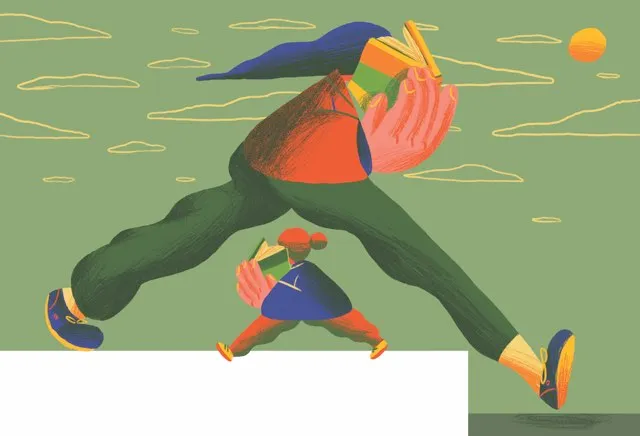
Events that are novel, shocking, important or painful are encoded more easily than banal ones because the neural activity involved is more intense. Encountering a flame and getting burned by it, for instance, involves fast and furious firing of visual neurons (the sight), somatosensory neurons (the feeling) and limbic neurons (the horror). A subsequent glimpse of flame then triggers activity in the whole network, including the neurons that registered the burn. This memory, even if it’s not conscious, guides our response to the new situation: instead of touching the flame, the body recoils. A lesson has been learned. Networks of linked neurons break down and build up much more easily in young brains than in older ones, which is why children learn – and forget – things so quickly.
Some things are easier to learn than others. Walking and talking, for instance, emerge without much help, provided infants see it happening around them. Natural skills like these generally emerge within specific time frames, when children’s brains are genetically programmed to develop them. Newfangled skills such as reading and arithmetic, however, have to be learned deliberately, along with non-intuitive knowledge like the offside rule in football or the laws of thermodynamics. In each case, repeated practise and study will strengthen the neural networks associated with this knowledge and help commit it to memory.
Some types of learning are facilitated by so-called ‘mirror neurons’ – brain cells that become active in a person when they see someone else doing something. If you see someone lifting their arm, say, some of the neurons in your brain which would be involved in lifting your own arm start firing. Mirror neurons provoke automatic mimicry, which is particularly useful for learning motor skills – a dance routine, for example, or how to serve a tennis ball.
The hippocampus not only converts experiences into knowledge, but to some extent stores this knowledge too. A famous study of London taxi drivers who had acquired a detailed mental map of the city streets found that the back part of their hippocampus was considerably larger than normal. Another important brain area for learning is the ‘fusiform face area’. This patch of cortex, situated behind each ear, encodes faces, and has links to the language and emotional brain areas that generate names and feelings when you see a familiar face.
Tune up your learning
- Take notes and re-read them frequently. Repetition prevents information from being forgotten because it reignites and helps solidify the neural networks that hold memories. Try the Cornell note-taking method:
- Record the information of a lecture as notes
- Devise exam-type questions based on your notes
- Answer your questions aloud, without consulting your notes
- Reflect on your notes and your answers
- Review your older notes regularly
- Revise for an exam in a room scented with something unusual then put a bit of this scent on your wrist before the exam and sniff it if you are stuck. This is particularly effective if the material has an emotional component: in a 2011 study at Utrecht University, volunteers watched an emotionally engaging film in a room smelling of cassis (a fruity smell similar to blackcurrant). Later re-exposure to the smell triggered strong recollections of what they had seen.
- Break information into chunks. For example, turn the sequence 8,3, 2, 4, 9, 0, 1, 9, 8 into 832-490-198. This makes it easier to keep in ‘working memory’ – the brain system that keeps new information circling in a neural repeat loop until it is used, learned, or replaced by new input. Most people can only cope with five or so ‘items’ in this loop. In our example, chunking effectively turns nine items into three.
Follow Science Focus onTwitter,Facebook, Instagramand Flipboard
3
Memory
It comes in three flavours, and may betray your trust.
As we saw in the previous section, learning turns experience into knowledge. But our ability to remember and recall this information at a later date is what makes this knowledge useful. And that’s all down to our memory.
Our brains are very selective about what they memorise. Most experiences pass us by and fade into oblivion because there’s no need to stuff our heads with memories which are unlikely to be useful.
When we do remember things, the system we use can be one of three types, each of which uses a different brain process. ‘Working memory’ uses fast-firing neurons to hold new information temporarily in mind for immediate use, short-term memory is a separate system that involves temporary changes to neural firing patterns in the brain, while long-term memory involves permanent changes in the brain’s tissue which are unlikely to disappear until the tissue itself dies or is damaged.
As we age, it gets more difficult to hold things in mind because the neurons which suppress distractions are less efficient. Meanwhile, laying down new long-term memories is more difficult because our brains are less plastic. We also find it harder to access information, even when it is well-learned. This may be because we no longer have direct pathways to it. Memory is ‘state-dependent’ in that it needs to be prompted by something associated with it. A retired lawyer, for example, may retain complete knowledge of their area of law but be unable to come up with it until they revisit their old office or courtroom.
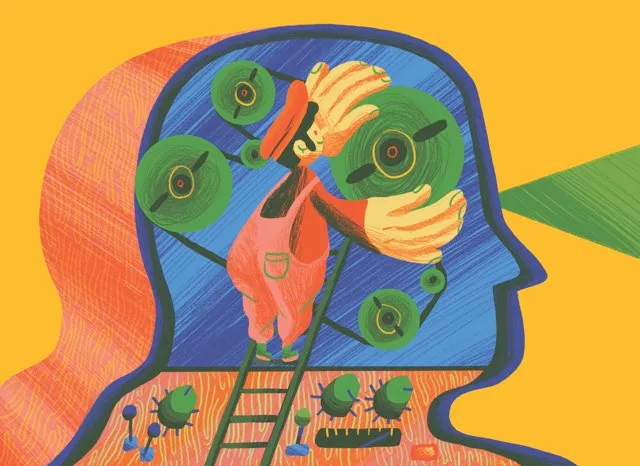
Forgetting things we want to hold on to is one type of memory failure. Another is inaccurate or fabricated recall. Remembering something that happened to you is to re-experience it – up to a point. Recalling a rainy day on holiday, for example, involves activity in the sensory neurons that originally produced the feel of the water droplets and the sight of the cloudy landscape, together with those that produced an emotion (disappointment, maybe, at not being able to enjoy the beach). Neurons that registered the faces of the people you were with might fire again, together with those triggered by the food you were eating.
While this brain activity is similar to the patterns that occurred at the time, it is never identical. Even when we’re thinking about the past, our brain is keeping tabs on the present, so our neurons are being stimulated not only by the memory, but also by the sounds, sights and smells around us. The patterns are fused together, so every time we recall a memory, we add something of the present moment. Eating a pizza while recalling that rainy day, for instance, might cause the pizza to enter the memory, so that next time you might remember eating a quattro formaggio as that holiday rain fell.
Memory distortions like this are inevitable, and sometimes dangerous. Several decades ago, psychologist Elizabeth Loftus demonstrated that false memories can be planted in people’s minds with astonishing ease. Now, researchers have discovered a new twist: ‘choice blindness’. This refers to people’s failure to notice when their own statements are falsified. It has huge implications for criminal law, which depends on witness reports. In a 2016 study at the University of California, volunteers identified the culprit of a staged crime from a line-up. Two days later they were invited to confirm their choice but, unknown to them, were presented with a photo of a different person. Two-thirds of the volunteers agreed this was the culprit they had first identified.
So it’s clear that memory is a fickle creature, and that we should take our recollections with a pinch of salt.
Tune up your memory
- Consuming lots of B vitamins (found in whole grains, seeds, nuts and beans) may help. These aid many brain functions, including neurotransmitter production. One study found that high doses of B vitamins halved the rate of brain shrinkage in people with mild memory problems. But the jury is still out on vitamin B.
- Use mnemonics such as rhymes (‘30 days has September’) and acronyms (‘Richard Of York Gave Battle In Vain’) – both tried-and-tested ways of making information more memorable.
- Construct a mental picture of a familiar location, such as your home, and place things that you want to recall in its rooms so that you can mentally stroll through the image and spot the unfamiliar items you’ve stored there – a bit like Sherlock’s ‘mind palace’.
- Write a to-do list each morning and consult it at regularly throughout the day, to keep it fresh in your mind..
- Establish habits such as putting your keys on a particular hook every time you come in. This establishes a link in your brain between the objects (e.g. the hook and the keys), so that when you need your keys you automatically remember the hook, rather than trying to recall, each time, where you put them last.
Follow Science Focus onTwitter,Facebook, Instagramand Flipboard
4
Problem-solving
When brute-force intellect fails, expand your mind.
Solving problems draws on two types of intelligence: crystal and fluid. Crystal intelligence involves using stored knowledge to answer questions of fact (e.g. what is the speed of light?), which in turn relies on our ability to learn and remember information.
Fluid intelligence involves solving more creative problems, such as how to get a lion, a goat and a cabbage over a river in a single-passenger boat. This kind of intelligence has proven more difficult to get to grips with, partly because solutions tend to pop, fully formed, into consciousness as “aha!” moments, and no amount of introspection reveals the cognitive processes that led to them. It also seems that our brains use different strategies for different types of puzzle.
We tend to work out simple problems – those involving just a few factors – methodically. For example, to solve “If ABC = 123, then DEF = ?” you need to know three things: the alphabet, the number sequence, and the coding technique of linking two sequences in parallel. Once you have this knowledge, you can find the answer by matching letters to their appropriate numbers, without having to look elsewhere for any extra information. In this case, focusing attention on the problem helps you get to the right solution.
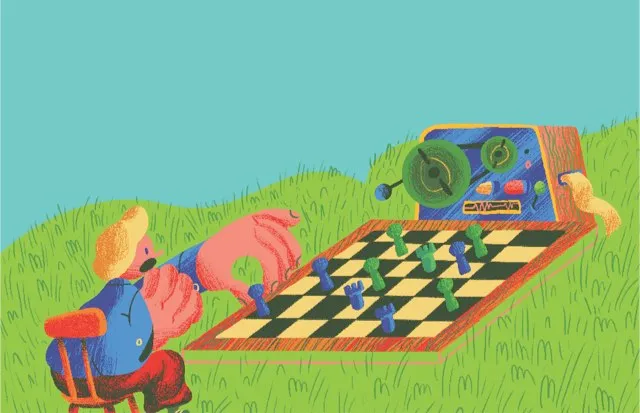
Complex problems, on the other hand, require a different approach, because the number of things you need to know and juggle is greater than your conscious brain can cope with. A chess move, for example, can lead to billions of outcomes, and no human brain can think through them all, let alone hold them in mind simultaneously in order to compare them. Inexperienced chess players typically react to the complexity of a chess problem by concentrating hard on working out possible sequences of events. Rather than helping them, however, this intense, narrow attention can make their play worse.
The reason is that focusing attention on sequential computation, which is done by the brain’s left hemisphere, closes down areas of the right hemisphere that are concerned with taking a wider view. Master players, by contrast, use their right hemispheres as well as their left. The right-hemisphere activity produces an intuitive sense of the gist of the problem and provides context for the conscious computations occurring in their left hemisphere. This use of intuition, when honed by years of experience, distinguishes experts from novices not only in chess, but also in every area that requires complex problem-solving.
A 2008 study at the Medical University of Vienna shed further light on how narrow concentration can hinder problem-solving. By monitoring volunteers’ brainwaves as they struggled to solve a word puzzle, the researchers found that intense attention locks the brain into a particular pattern of activity, producing cognitive tunnel vision. Low-level attention, in contrast, allows neural patterns to change, making it easier to incorporate new information. It’s the difference between trying to work out what an object is by staring at it from a single perspective, or ambling around it, receptive to anything that might give guidance.
As well as looking at a problem from multiple angles, brilliant problem-solving involves dismissing bad options quickly, before they can use up limited cognitive resources. This ability has recently been introduced to artificial intelligence, producing machines that for the first time are able to beat the best human players at Go, an ancient Chinese strategy game. This ‘self-learning’ type of AI can rehearse its strategies, note those which don’t work, and feed the information back into the system, tagged with an instruction to avoid them in future. In the human brain, a similar process is executed by an area called the anterior cingulate cortex (ACC). This tiny bit of tissue, tucked into the deep fold that divides the two hemispheres, probably did more than any other brain region to make humans the best problem-solvers on Earth. Until now, perhaps.
Tune up your problem-solving
- Challenge yourself with increasingly complicated problems. Eventually your brain will learn to abandon the fixed-attention strategy it uses for simple problems, and start to look at problems from multiple points of view.
- If you’re stuck on a puzzle, shift attention elsewhere and come back to it later. This turns off the neural firing pattern that is locking the brain into an unsuccessful approach, and allows the brain to incubate the problem, casting around unconsciously for knowledge that might be useful. When you return to the puzzle, this new information is likely to be incorporated into the problem-solving attempt.
- Combine problem-solving with a low-level activity such as walking or jogging. This helps to reduce focused attention because you need to use some of your conscious resources on the activity you’re performing. It also increases blood flow and endorphin release, which perks up brain cells just as it does cells in other parts of the body.
- Brainstorm privately. Complex problems often require left-field solutions, so thinking far and wide, in areas which do not immediately seem relevant, can help broaden your perspective. The dafter the ideas you allow yourself to come up with, the freer your brain will be to stumble upon a solution.
Follow Science Focus onTwitter,Facebook, Instagramand Flipboard
5
Creativity
The recipe? An elusive blend of focus and relaxation.
Human creativity has long been something of an enigma, but a fortuitous discovery led to a breakthrough in our understanding of this slippery subject.
Most brain studies have involved asking volunteers to perform tasks – matching words, say, or doing calculations – while their brains are monitored by some sort of imaging technology. This has allowed scientists to build up detailed ‘maps’ of what is happening when we’re doing things. For many years, however, no one thought to look at what happens in our brains when we’re not doing things. As luck would have it, there was plenty of data to hand because most brain studies involved rest periods whereby volunteers were told to relax and think of nothing in particular. Their brain activity in this state was usually recorded along with the active phases, but ignored.
Eventually, by chance, it was noticed that the brain activity seen in ‘no-thought’ states was similar in practically everyone. The pattern was named the default mode network (DMN), and it has turned out to be the key to human creativity.
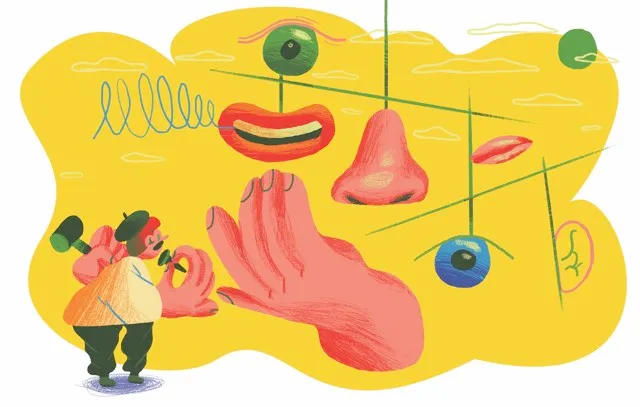
The DMN is the opposite of another electrical pattern known as the executive control network (ECN), which lights up when we’re in a ‘doing’ state. In the ECN, the brain’s neurons fire rapidly, but in relatively few areas. This is goal-directed activity, and it locks the brain into focused thinking. When a person stops pursuing a particular goal, however, their brain activity switches to the DMN, marked by low activity in a large and diffuse collection of brain areas. This state feels relaxed and free-ranging. The thoughts that arise tend to revolve around the individual, and involve past and imagined social scenarios. A person might, for instance, recall a conversation from earlier that day, or rehearse what they will say to someone they are due to meet later.
In the DMN, imagination comes to the fore. Because the brain is unshackled from the need to form and execute a particular action plan, it’s able to try out lots of different ideas, imagining and comparing their outcomes. It also allows thoughts and memories to link up temporarily in unusual ways, creating an internal, near-surreal kaleidoscope in which fish may fly and pigs may talk.
Imagination is not the same as creativity, however. A brain that is completely unharnessed may throw up wildly imaginative ideas, but they may merely seem unhinged. To be creative, ideas need to be useful (e.g. a better mousetrap) or wrapped in talent (e.g. a Dalí painting). So to harness the output from the DMN, the brain has to fire up the ECN, or at least part of it.
Usually, activation of the ECN automatically turns off the DMN, and vice versa – we flip-flop from one state to the other. Research suggests, however, that creative people are able to activate both networks at once. In a study last year, people’s brains were scanned while they tried to think of imaginative uses for a sock, for soap and for a chewing gum wrapper. Some volunteers just couldn’t do the task: they could only think of things like “covering the feet”, “making bubbles” and “containing gum”. Other volunteers suggested a water filtration system, a seal for envelopes, and an antenna wire. These creative thinkers, unlike the others, were found to be activating both the DMN and parts of the ECN simultaneously.
Can you learn to get this particular neural pattern going? So far, no one has put it directly to the test. However, brain activity is habitual, like the behaviour it produces, and if you sense a lack of creativity in yourself, you can encourage it to grow.
Tune up your creativity
- Look out of the window when you’re next on public transport instead of using your phone. Studies have shown that daydreaming and boredom can allow the mind to wander, helping to foster creativity.
- Cut up pages of a newspaper and rearrange the words to make grammatically correct nonsense statements. By keeping the words within the structure of grammar, the new sentences keep some kind of meaning, forcing the brain to look at the content in a new way – a handy skill for creative thinking.
- Turn down the lights: a 2013 study by psychologists at the Universities of Stuttgart and Hohenheim in Germany found that dim lighting can improve creativity. Darkness, they say, creates a feeling of freedom, triggering “a risky, explorative processing style”.
- If you’re reading a story, stop the narrative mid-flow and think of five different possible endings.
- Transform your current visual experience into something odd. For example, imagine all the objects around you turned upside-down. Can you see a new use for any of them in this state?
- Interrupt a daydream by trying to think of some way to use it in real life, perhaps by polishing it into a story, or a party anecdote.
Follow Science Focus onTwitter,Facebook, Instagramand Flipboard
6
Decision-making
So-called free will and the emotionally fraught business of choice.
Every decision we make is arrived at through hugely complex neurological processing. Although it feels as though you have a choice, the action that you ‘decide’ to take is entirely dictated by automatic neural activity. Brain imaging studies show that a person’s action can be predicted by their brain activity up to 10 seconds before they themselves become aware they are going to act.
This has huge implications for our concept of free will, which scientists and philosophers are still grappling with today. Multiple neuroscientific studies show that even those important decisions that feel worked out are just as automatic as knee-jerk reactions (although more complex). The sense of volition seems to be a clever illusion perpetrated by our brains, and the illusion is useful because it gives us a sense of responsibility – and causes us to moderate our behaviour accordingly.

Decision-making starts with the amygdala: a set of two almond-shaped nuclei buried deep within the brain, which generate emotion. The amygdala registers the information streaming in through our senses and responds to it in a split second, sending signals throughout the brain. These produce an urge to run, fight, freeze or grab, according to how the amygdala values various stimuli.
Before we act on the amygdala’s signals, however, the information is usually processed by more sophisticated brain areas, including some that produce conscious thoughts and emotions. Areas concerned with recognition work out what’s going on, those concerned with memory compare it with previous experiences, and those concerned with reasoning, judging and planning get to work on constructing various action plans. The best plan – if we are lucky – is then selected and executed. If any of this process goes wrong, we are likely to dither, or do something silly.
The various stages of decision-making are marked by different types of brain activity. Fast (gamma) waves, with frequencies of 25 to 100 Hz, produce a keen awareness of the multiple factors that need to be taken into account to arrive at a decision. If you are trying to choose a sandwich, for instance, gamma waves generated in various cells within the ‘taste’ area of the brain bring to mind and compare the taste of ham, hummus, wholemeal, sourdough, and so on. Although it may seem useful to be aware of the full range of choices, too much information makes decision-making more difficult, so irrelevant factors get dismissed quickly and unconsciously. At the sandwich counter, the cheese and tomato option might trigger only the tiniest flurry of neuronal excitement.
After this surge of activity marking the comparison stage, the brain switches to slow-wave activity (12 to 30 Hz). This extinguishes most of the gamma activity, leaving just a single ‘hotspot’ of gamma waves which marks the chosen option.
Although there is no ‘you’ outside your brain to direct what it’s doing, you can help it to make good decisions by placing yourself in a situation which is likely to make the process run more smoothly. Doing something that is physically or mentally stimulating before making a decision will help your brain produce the initial gamma waves that generate awareness of the competing options. Getting over-excited, on the other hand, will prevent the switch to the slow brainwaves, making it much harder to single out a choice. Subjecting yourself to high emotion may also warm up the connecting pathways from the amygdala to the action areas of your brain, causing panicky or impulsive behaviour.
Tune up your decision-making
- Make a list of your bad decisions and look for links. Were they all compromises, for example, or made hastily? When you identify a link, analyse the mental strategy that you used, and try deliberately using the opposite strategy for a while. If the problem seems to be haste, for example, delay the decision, and be ready to acknowledge any vaguer, subtler factors that come to mind.
- Brainstorm before a decision, then sleep on it before acting. Like creative thought, good decision-making benefits from unconscious incubation, in which the brain drifts around, rummaging through memories that might be useful. Sleep is an extreme case of incubation, and your dreams may throw up important clues that make your decision clearer upon waking.
- Mentally step back from the situation and ask yourself what others might do. This will force your brain to look at the situation from a new perspective, which may reveal factors you had not previously taken into account.
- Write down your favoured option, then highlight the emotional words. If you delete the highlighted words, is the decision still looking good? If not, these words are your real reasons for the decision. ‘Attractive’ or ‘exciting’ may be valid factors in deciding on a date, but not so good if you’re choosing an accountant.
Follow Science Focus onTwitter,Facebook, Instagramand Flipboard
7
Does brain-training work?
The verdict on games, crosswords and other ‘brain-boosting’ exercises.
The brain is like a dense conglomerate of muscles, each one dedicated to a particular task. Exercise any one of them and it will get stronger, but you need to exercise them all to improve your general cognitive ability. If you practise adding up figures all day, for instance, you will get very good at adding up figures, but if you never resort to estimation – a skill performed by an entirely different brain ‘muscle’ from arithmetic – you will be no better than anyone else at judging, say, the size of a crowd.
Brain-training has been dogged by the difficulty of developing exercises that improve functioning across the brain rather than in one small part. It’s now recognised that suites of exercises – those that package together visual search exercises with motor coordination challenges and word-retrieval games, for instance – can have broad benefits. However, if you have a healthy brain capable of a normal range of skills, the best exercise you can get is real life. Taking an active part in the community, enjoying art, listening to music, engaging politically and enjoying a rich social life – these are the best training of all.
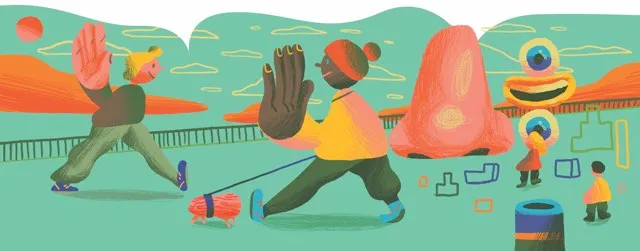
Not all of us, however, have optimally healthy brains. Nor is it always possible to develop or practise the full range of cognitive skills. Brains degenerate physically with age, just like every other part of the body, and many people can’t live life to the full because they’re locked into repetitive work or cut off for some reason from intellectual stimulation.
When people get older, their neurons tend to be less excited by environmental stimuli. This is partly due to reduced hormones and neurotransmitters, but partly because fewer events are novel and stimulating. Our brains have ‘been there, done that’, and are not inclined to use too much energy doing it again. Just as brain activity primes the brain to activate in the same way again, subdued brain activity reduces future activity. So, whether you go for computer gaming, reading, listening to music or playing sport, the first thing brain exercise should do is get you excited.
The second thing it needs to do is to work as many cognitive muscles as possible. Crosswords are the famous go-to exercise because they involve several elements of cognition: memory, problem-solving, and spatial sensitivity (noticing how the words fit together). If you do crosswords too often, however, you may get so good at them that they no longer stretch you. The person who boasts that they complete a broadsheet cryptic puzzle every day may be doing less for their brain than someone who struggles to solve a single clue in a much simpler puzzle.
The same is true of Sudoku. The numbers game can be very challenging, especially for newcomers, but doing Sudoku every day merely makes you better at Sudoku – a skill that is quite difficult to find a use for elsewhere.
Should you take supplements?
A varied diet should provide all the brain-healthy nutrients you need, but could you benefit from taking more of them? Omega-3 – the fatty acids found in fish such as herrings, sardines and mackerel – is the supplement best known as a brain-booster. But the evidence for its effects is underwhelming. A 2012 review by the Cochrane organisation – widely acknowledged as an authority on health research – found no evidence that omega-3 reduces the risk of cognitive impairment, while a 2015 meta-analysis by Canadian scientists concluded: “Omega-3 fatty acids, B vitamins, and vitamin E supplementation did not affect cognition in non-demented middle-aged and older adults.”
Similarly, evidence for the herbal supplements ginseng and ginkgo biloba fails to stand up to scrutiny. The same goes for practically every other so-called brain-booster. The Natural Medicines Comprehensive Database, a non-commercial organisation that continuously collects and reviews data, failed to find a single proven effective supplement among more than 50 they assessed. They rated a few as “possibly effective” but most simply had “insufficient evidence” to make a judgment.
Lack of proof of efficacy is not, however, proof of lack of efficacy. The large-scale, expensive research needed to show beyond doubt whether something works is usually done only for medicinal drugs, so it’s not surprising that there’s no concrete evidence for the effects of supplements in healthy people.
Supplements are not without risk – they can interfere with medicines and produce nasty side effects, especially if too many are taken. However, a supplement that gives the recommended daily dose of required vitamins and minerals may be a good idea if you feel your brain needs a boost, especially if you think your diet may be deficient in some way. Just consult your doctor if you experience any side effects.
Follow Science Focus onTwitter,Facebook, Instagramand Flipboard
8
The future of brain-training
Can electrical stimulation and ‘smart drugs’ boost brainpower?
Strapping electrodes to your skull to stimulate your brain with a buzz of electricity might sound scary, but done properly, non-invasive ‘transcranial direct-current stimulation’ (tDCS) is safe – it uses a minute charge and feels tingly but not painful. tDCS is extremely well-researched – it features in more than 2,000 studies published in mainstream academic literature – and has been found safe and tolerable, even for children.
So would you benefit from tDCS? Many studies have found that it improves a wide variety of cognitive skills, and helps relieve mood disorders such as depression, but there are some studies that show minimal or no benefit. Generally, around 10 to 20 minutes of tDCS a day seems to have modest, cumulative effects. Most studies have been conducted on people with brain problems, however, so results can’t always be applied reliably to those with healthy brains.
Another thing to bear in mind is that the effect of tDCS depends on where the electrodes are placed on the head. There is a ‘sweet spot’ (the dorsolateral prefrontal cortex’) which tends to be the default option because it has positive effects on mood, memory and cognition. Other benefits require different placements. Some tDCS devices come with a ‘map’ of electrode locations.
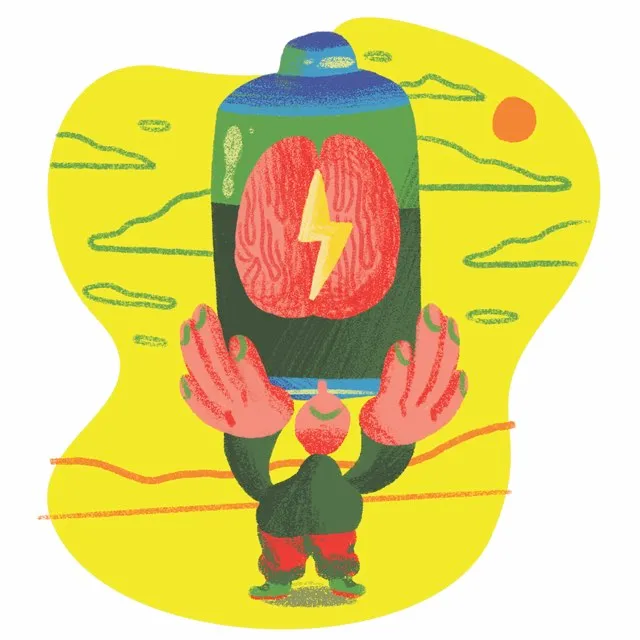
There are dozens of DIY devices on the market – established makes include foc.us and TheBrainDriver. To date, there are no legal barriers to the direct-to-consumer sale of tDCS devices, but do your research before buying. Some are expensive machines aimed at research, which include features that are unnecessary for home use. At the other end of the spectrum, the cheapest, home-made tDCS devices may not have reliable timing mechanisms or adequate safety measures, such as an automatic cut-out in the event of an electricity surge. There is limited independent research on how well consumer tDCS devices work, however.
Smart drugs
‘Smart drugs’ is an umbrella term for hundreds of substances claimed to boost brainpower. About 12 per cent of university students are thought to use smart drugs in the hope of improving their performance, with many available to buy easily online.
Also known as ‘nootropics’, these include some prescription drugs such as Ritalin and Adderall, which are licenced for attention-deficit disorders, and modafinil, a treatment for narcolepsy. These have proven benefits for patients, but whether they work for healthy people is less clear. And they can have adverse effects, so you would be unwise to take them without advice from your GP.
Smart drugs also include herbal supplements, which may claim plenty of proof of efficacy, but have not been put through the rigorous trials needed for prescription medication.
Follow Science Focus onTwitter,Facebook, Instagramand Flipboard
